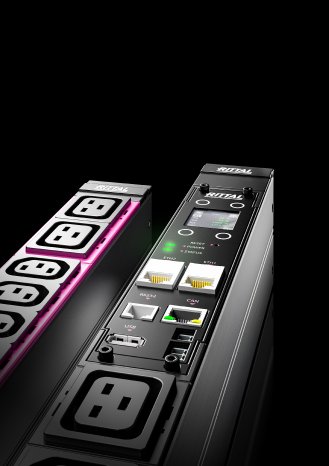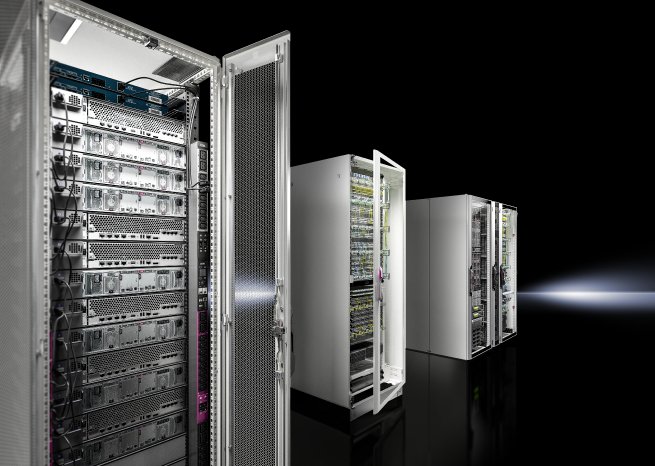It has been estimated that data centres consume as much as 500 billion kilowatt hours of energy globally . By 2030, demand could even rise to as much as 2,000 billion kilowatt hours . In Germany, too, experts expect IT systems’ demand for energy to rise, driven by new technologies such as 5G networks and the Internet of Things.
Measuring and streamlining power consumption is thus becoming ever more important for data centre operators. With a new family of PDU products, Rittal is now offering comprehensive functions for energy metering in the IT rack and helping to cut IT operating costs in the data centre.
“Despite the many efficiency gains that have been achieved in IT so far, energy consumption is continuing to grow in many data centres. With our new range of PDUs, we are helping data centre operators to analyse energy costs precisely and to make the most of any further potential for optimising costs,” explains Luis Brücher, Vice President Product Management IT at Rittal.
Five models to meet every application
The new generation of PDUs comprises five basic models that are functionally based on each other and which can be individually configured. These are the:
- Rittal PDU Basic (simple power distribution)
- Rittal PDU Metered (measurement per phase)
- Rittal PDU Metered Plus (measurement per phase)
- Rittal PDU Switched (measurement per phase, switching function per output)
- Rittal PDU Managed (measurement and switching per output)
A space-saving format and toolfree assembly
One of the special characteristics of the new PDU generation is its slimline design. The Rittal PDUs can be installed in the zero-U-space – in other words, in the space between the side panel and the 19" mounting frame. This way, no height units are blocked, and maintenance and installation activities are still possible, even with a fully configured IT rack. In Rittal IT racks, installation is performed without the need for any additional tools, simply by using a clip fastening on the 19" frame; in third-party IT racks it is done using the universal fasteners supplied.
Modular systems for maximum flexibility
In addition to a large number of PDU items from stock, a modular production concept permits custom configuration options. This way, the PDU can be ideally adapted to the application. Customers themselves can determine the length of the cable, the connector to be used or the number and type of socket locations. The configuration of protective contact outputs is a new feature. Furthermore, additional modules can be configured to form a PDU, such as residual current measurement or overvoltage protection features for example. Thanks to the modular concept, individual components like the PDU controller board and surge protection can be replaced while the unit is running, so boosting the data centre's availability.
The configurator: Easy ordering and fast delivery
To make ordering quick and easy, Rittal has developed a web configurator. It guides the customer comfortably to the desired solution via all the configuration options: https://www.rittal.com/pdu
Security via remote access and monitoring
With intelligent PDUs, security and monitoring are important functions. For example, one or two of the electronic handles installed on an IT rack can be used for access control monitoring. Further integrated functions such as an alarm relay, a digital input and alarm signalling device allow the PDU to be flexibly integrated in a comprehensive IT security plan. In addition, the sensors already available for the CMC III monitoring system can also be integrated, so that environmental data such as temperature, humidity or the status of switching contacts can be recorded. A residual current monitoring feature is also available as an option. The PDU’s intelligent logic elements can, for example, prevent doors from being opened if a potentially dangerous situation has been detected due to a drain-off of current via the PE (Protective Earth) or other paths within the IT rack.
The PDUs also feature an integrated web server for remote management. The administrator is provided with an intuitive web interface for this purpose. The access rights to the web server can be assigned automatically by means of common directory services such as Active Directory. Besides the detailed point-and-click display of measured values on the web interface, the PDU parameters can also be queried via SNMPv3 from higher-level DCIM (Data Center Infrastructure Management) software systems. There is support for the most common protocols such as TCP/IPv6, TLS, and OPC-UA.
Practical: PDUs in use, from edge to colocation
Specific application scenarios exist for each product variant. For example, a “metered PDU” supports load management in the IT rack. This lets IT experts decide whether the IT cooling is optimally matched to the load of the active components. One measurement per output slot, as supported by the “Metered Plus” model, allows detailed billing based on individual consumers. Operators of colocation data centres can use this variant to monitor the costs of rented server space or of entire IT racks. The “PDU Switched” variant has a switching function that makes it possible to interrupt the power supply for individual slots or to switch it on again if needed. This makes it much easier to administer remote IT locations, such as autonomous edge data centres. “PDU Managed” variant allows measurement and switching for each output, resulting in user-oriented billing with full control over the slots. In large decentralised edge infrastructures in particular, managed PDUs are the ideal tool for recording costs per site while at the same time remotely monitoring the IT systems.
Overview: Key facts and customer benefits
- Extensive measurement functions for detailed energy analysis in the data centre
- Flexibly configurable and ideally adaptable to the respective application in the company
- End-to-end monitoring functions to increase the security of the entire IT infrastructure
- Rapid and space-saving installation
- Remote administration with a maximum of access security




